On the Road is a weekday feature spotlighting reader photo submissions.
From the exotic to the familiar, whether you’re traveling or in your own backyard, we would love to see the world through your eyes.
On the Road: Week of March 22 (5 am)
Albatrossity – Brazil 2010
way2blue – Logar valley (Logarska Dolina), Slovenia
?BillinGlendaleCA – The Brand Family Cemetery (IRChrome)
Steve from Mendocino – Shape Studies in Black and White 2/2
Mike in Oly – Waterfalls of Western Washington
? And now, a treat from Albatrossity!
Holy cow! One of the perks of doing On the Road is that I get to pick the favorite photo that will show up on social media. For this one, I thought “that’s the featured image!” no fewer than 4 times. Wow. ~WG
Albatrossity
Brazil is a country that is much in the news today, and usually for all the wrong reasons. Pandemic mismanagement, virus mutations, rainforest destruction, and a president whose behavior is making all of that worse. But it is a lovely country, and so I thought I should share some pics from the time I have spent there. I hope to go back someday; we had plans for summer 2021, but somehow that didn’t seem prudent when the time arrived). So for now, these pictures will have to suffice.
I was fortunate to accompany a university Study Abroad class to Brazil in 2010, 2011 and 2013. We visited several different parts of that large and diverse country, but every trip included some time in the Amazon rainforest, centered around the city of Manaus, the capitol of the state of Amazonas. The 2010 trip, in fact, was entirely in that region. Here are a few images from that year’s trip.
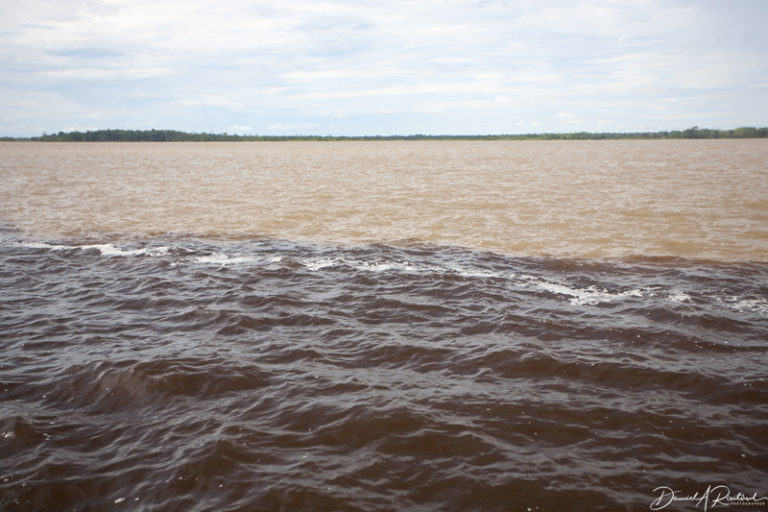
Manaus is located at the junction of two major rivers, the Rio Negro and the Solimões. The former is a warm tropical river, flowing from Colombia southward into the rainforest. It gets its name from the fact that it is a blackwater river, acidic and full of tannins leached from the leaves of the tropical forests through which it flows; the water is the color of weak tea, but otherwise very warm and clear. The Solimões, on the other hand, originates in the glacial melt of the high Andes. It is much cooler and full of sediments washed off those mountains. From Manaus you can take a boat trip to the Meeting of the Waters, where the cold sediment-filled Andean river meets the warm clear tropical river. These disparate waters flow side by side for many kilometers, barely mingling. Here is a shot of the river as we approached the Solimões from the Rio Negro branch.
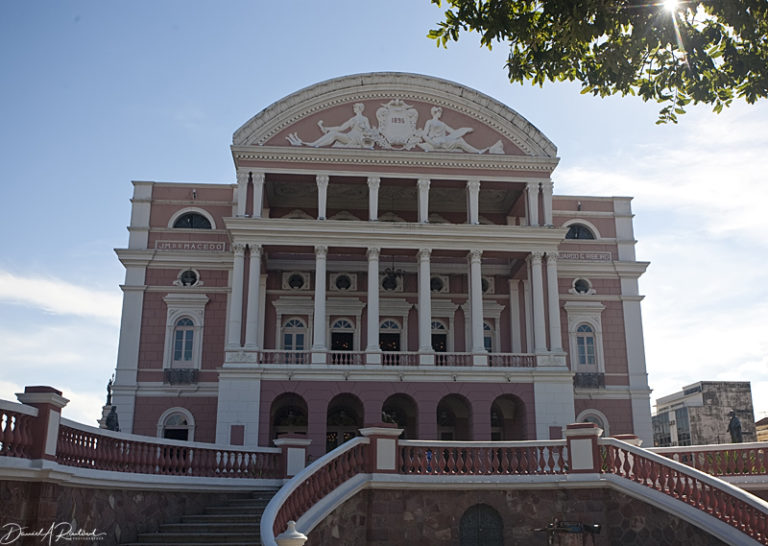
The city of Manaus was the center of the rubber boom of the late 19th century, and was thus also a center of wealth, so there are many architectural delights from that era. The most famous is the opera house, constructed at the end of the 19th century, and blessed with incredible rainforest hardwood floors as well as chandeliers made with glass from Murano. It is still a functioning opera house; during this visit we shared the hotel elevator with many musicians who were there for the staging of Lo Schiavo, by the Brazilian composer Carlos Gomes. There is an interesting story behind that opera as well.
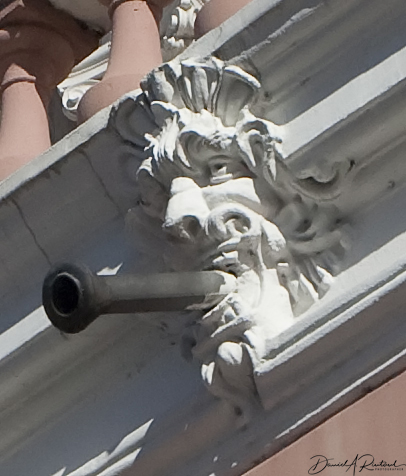
Architectural detail from the Amazon Opera House.
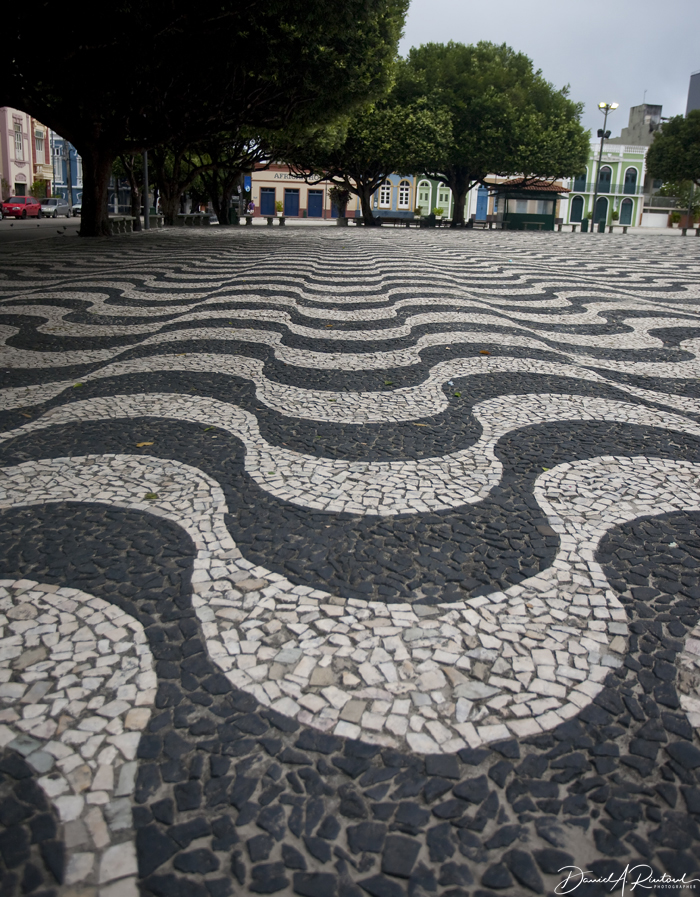
The plaza surrounding the Opera House has many grand houses, restaurants, and this inlaid mosaic design that evokes the Meeting of the Waters.
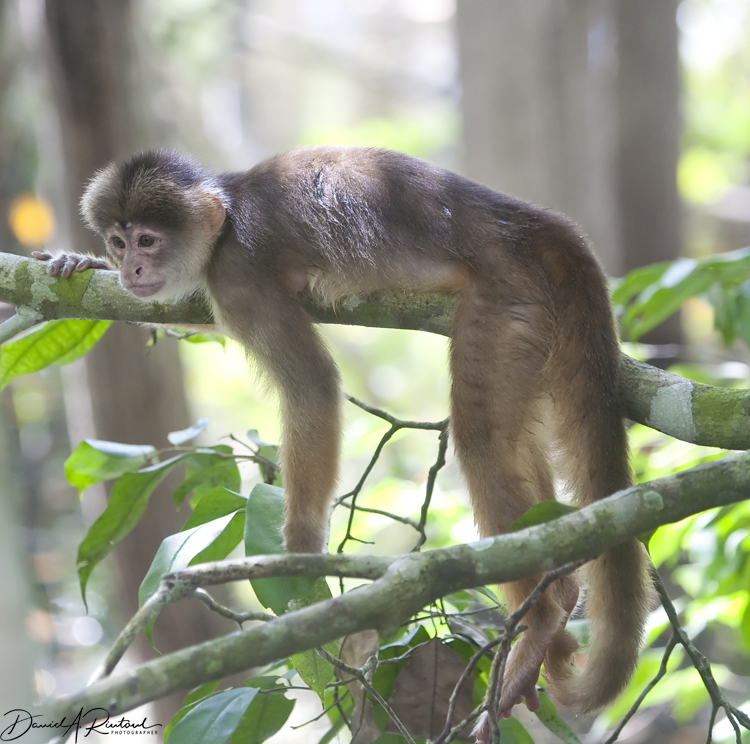
Our real destination, of course, was not the urbanized city of Manaus, but rather the Amazon rainforest. So we went up the Rio Negro to an interesting resort, the Ariau Amazon Towers. At the time a long boat ride from Manaus was the only way to get there, but the construction of a bridge over the Rio Negro now means that you can drive most of the way and take a much shorter trip to get there. We were greeted by many of these White-faced Capuchins, who took any opportunity to steal food or drink from the unwary students.
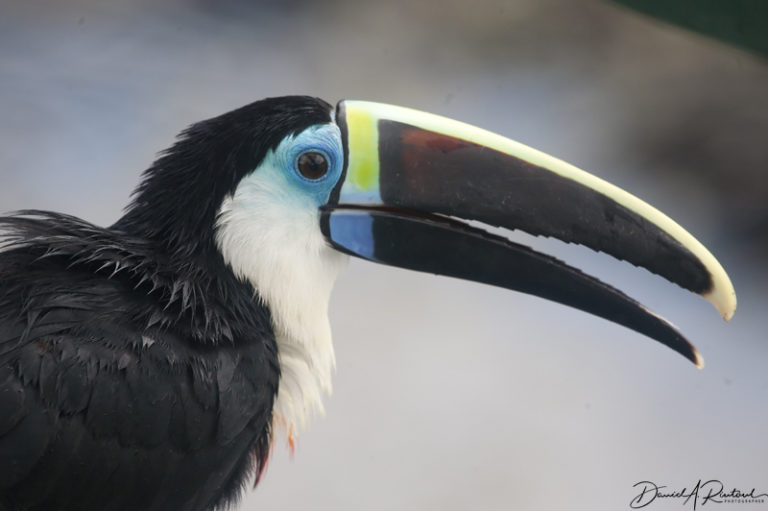
The area around the resort seemed to be the headquarters of this White-throated Toucan (Ramphastos tucanus), of the chestnut-billed Cuvier’s subspecies. Right before this photo he had been sitting out in the rain, which happened pretty much every afternoon.
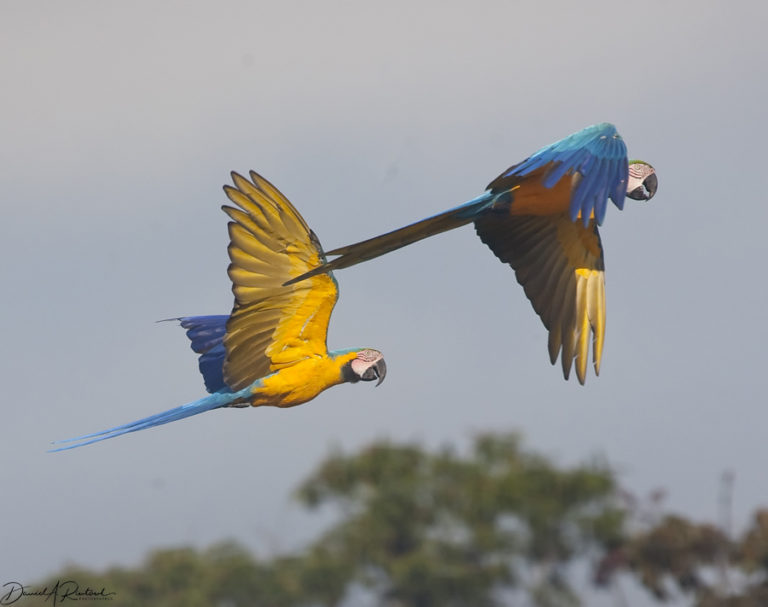
We were also regularly treated to flyby sightings of these Blue-and-gold Macaws (Ara ararauna), just to remind us that we were indeed in a tropical rain forest.
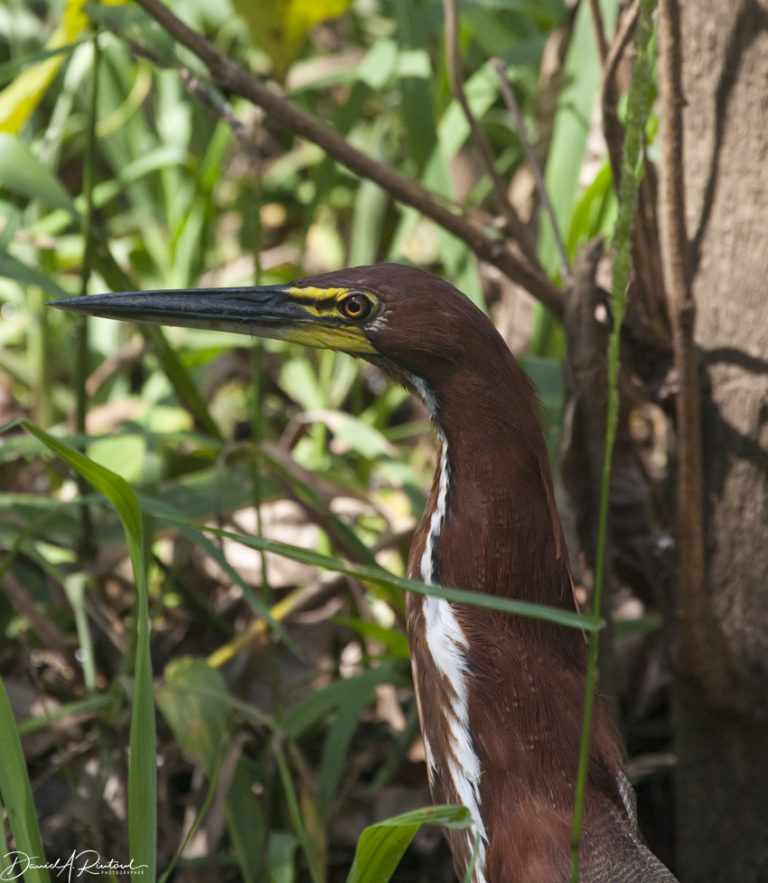
The resort has a series of boardwalks over that allow access to the flooded forests; we were there at the end of the rainy season, so the river was very high. This Rufescent Tiger Heron (Tigrisoma lineatum) was fishing alongside one of those boardwalks, and pretty much ignored me.
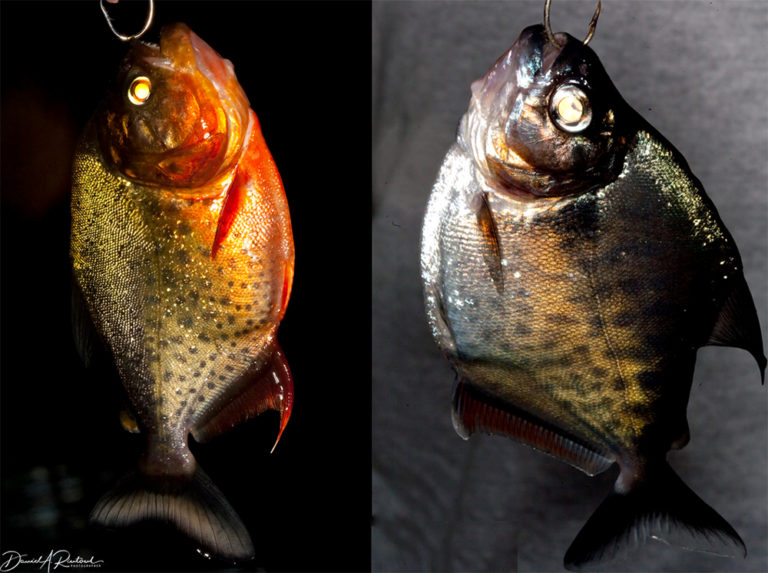
Some of the fish sought by this heron included the notorious piranha. We were able to fish for those ourselves, using hooks baited with chunks of beef heart, and the students were thrilled to catch them. Red piranha on the left, and black piranha on the right. We kept our catch, and the cooks back at the lodge fried them up for us to eat. I can report that they are very bony; there’s not a lot of flesh on these little flesh-eaters.
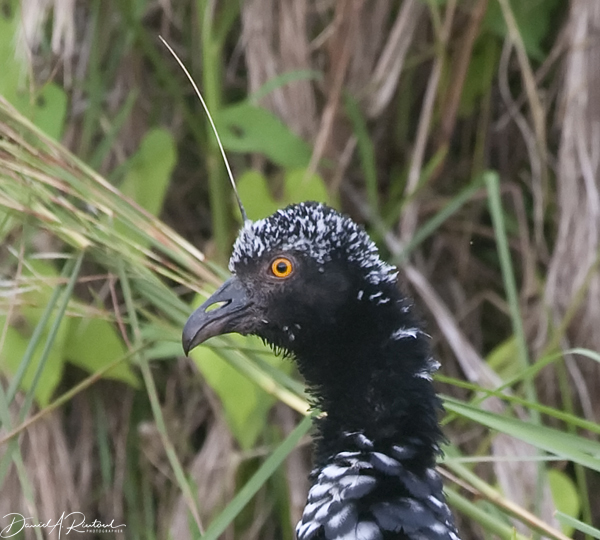
The coolest bird we saw might have been this Horned Screamer (Anhima cornuta), Screamers are a small avian family of three species (Horned, Northern and Southern Screamer), related to geese and swans phylogenetically, but truly bizarre otherwise. The horn is not a feather, but is a cornified outgrowth from the skull. It is a true horn, in other words, and is unique in the bird world.

Mary G
Wow! I love the toucan! And the macaws! The piranha you can keep.
Is there an evolutionary reason why so many of these rainforest birds are so brightly colored. So they can see each other through all the vegetation?
evap
Thanks as always for the wonderful pictures. Seeing a toucan in the wild must be an incredible experience. Since I know them only from cartoons and old Guinness ads, my brain doesn’t quite believe they exist. It’s nice to have proof that they do.
WG, I submitted some photos a few days ago. When we submit, do we get any indication that they were received? Just wondering if they actually made it to you.
Wag
Opera in the Amazon. Reminds me of the amazing movie Fitzcaraldo.
Albatrossity
@Mary G: There are plenty of little brown birds in the tropics as well! But there are just lots of bird species, and that means lots more of the colorful ones and lots more of the drab brown ones too. Tropical forests are hotbeds of bird species diversity, with more species per unit area than anywhere else.
Albatrossity
@Wag: It was really fun to see the opera scene in the middle of the Amazon. We were not there during the time when they were performing for real, but one evening we sat out in that plaza, eating pizza and drinking beer, while the dress rehearsal was happening. This opera was actually staged outdoors; the orchestra was in the orchestra pit inside the opera house and the music was amplified and broadcast outdoors. It was a gigantic production, with lots of extras and lots of locals, including schoolkids, having a bit part as a soldier, or a native villager. There were colorful costumes galore, and even some folks mounted on horses. There may or may not be pictures of me somewhere wearing a feathered headdress from one of those mounted extras…
arrieve
Wonderful pictures. I almost missed the horn in the last picture — thought it was part of the foliage. How do they not keep bumping their horns into everything as they move through the trees?
Albatrossity
@arrieve: They don’t spend a lot of time in the forest trees; you find them in marshes and along streams. But they do often break off the tip of that thing. Thankfully it grows constantly, just like a toenail on your head…
What Have the Romans Ever Done for Us?
Those are fantastic pictures. We were in Brazil in May of 2018 – one of my wife’s uncles was in the Peace Corps down there before the program got kicked out of the country and married a woman from Recife, and they’ve lived both down there and up here in the States – mostly here until they retired to Recife. We only saw Recife and surrounding areas and Rio de Janeiro. I know, everyone goes to Rio but it is the one place everyone says you have to see and it was indeed fantastic. The city is breathtakingly beautiful.
Albatrossity
Crane cam at Rowe Sanctuary this morning is amazing. Many cranes close to the camera
MelissaM
These are great. Did you touch the waters? Also, I personally would find it amazing to see a macaw in the wild – it’s a fancy pet in the US, so to see it flying in the wild would be … wild.
citizen dave
Was about to say cool pictures as always, but now also thanks for the crane camera recommendation! I was watching the northern lights the other night on an explore.org camera. Glad this one will be in my youtube list now.
Albatrossity
@MelissaM: Yes, it was amazing to drag your hand in the water beside the boat as it passed from the warm Rio Negro into the cool Solimões, or vice versa.
WaterGirl
@evap: Yes, you get an automatic email notification after a successful submission.
How big were the photo files you were submitting? Sometimes the form hangs if the photos are really large.
evap
@WaterGirl:
Too big could be a problem. I will try again.
WaterGirl
@evap: I forgot to state that I looked for the submission and didn’t find it, but I guess that was obvious!
Albatrossity
@citizen dave: The cranes will only be there for a couple more weeks. So watch ’em while you can!
cope
Gorgeous pictures, thank you very much. Nice of the macaws to be so accommodating.
I saw “Brazil” and “opera” so Herzog sprang to mind.
Steve from Mendocino
I love your sense of composition, as always. It’s interesting to see the evolution of your editing since then, particularly in your control of color. I’m guessing some of that has to do with different gear and better files to work with. Viewing the work of a talented photographer gives me the same pleasure now as it did 50 years ago.
Albatrossity
@Steve from Mendocino: Thanks! One of the joys of photography is the opportunity to be a lifelong learner. There is always something new, whether it be new locations, new gear, new editing tools, or just learning from looking at the work of others. Which I do, quite a lot, these days!
But yeah, the raw files from my DSLR in 2010 were 12-14 megapixels, which seemed like plenty at the time. Not so much these days!
StringOnAStick
@Albatrossity: Raining right now on the crane cam, I think I heard distant thunder. You can really hear the cranes though!
StringOnAStick
@MelissaM: We saw a pair of Toucans on the eastern side of Costa Rica; very wet and tropical on that side. It was great to see them sitting there on a branch, looking content with each other. None of those big birds should be pets though, they just aren’t suited to it. How can a cage or a house be close enough to being able to soar over the forest or miles?
I went to a large bird sanctuary near Naples, FL a few years ago. The caretaker was a woman who said she was doing it as penance for all the years that she raised and sold large birds. The sanctuary was filled with birds that had been pets but then became too dangerous to handle, and there was one room that no one but her was allowed into because the ones in there were just too traumatized. There was one umbrella cockatoo she pointed to, and told us not to take all the “come hither” stuff as it being friendly because it was a completely vicious bird that had badly injured the last person who tried. She had plenty of sad stories, most often of the cockatoos because as flock birds they are social and can be very loving pets until they reach sexual maturity at age 12. Then they can fixate on a human mate, decide your apartment is the nest and anyone else who enters is an invader who must be attacked, They can also screech at over 140 db. That’s what she had raised and sold, to her perpetual sorrow. She said “why would man look at these gorgeous creatures flying in the wild and think ‘I need to put that in a cage'”. I’ve never forgotten that moment. I love seeing them in the wild, and get a twinge of sadness when I see one being kept as a pet
There was an aviary with her remaining birds and a few surrendered ones that were safe to interact with; they clearly knew that when a tour group came by there was about to people in their aviary with yummy treats,
Albatrossity
@StringOnAStick: Wow. What a sad story!
But after seeing flocks of parrots in Australia, I also came to the conclusion that these smart and very social animals should never be kept in captivity.
way2blue
Wow. Those macaw are stunning! Beautiful photo. Again… Not yet visited South America, but our well traveled friends say the Amazon is their favorite. Here’s hoping the pandemic recedes in Brazil irregardless of Bolsonaro’s antics.